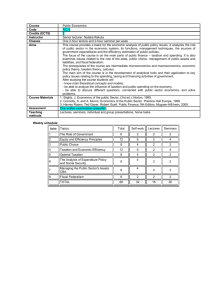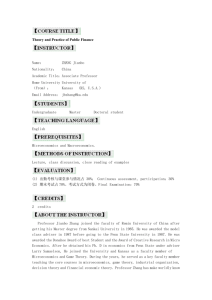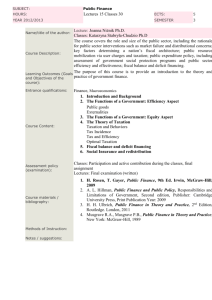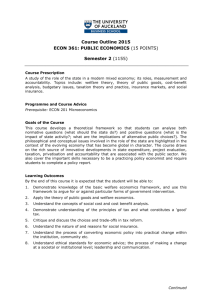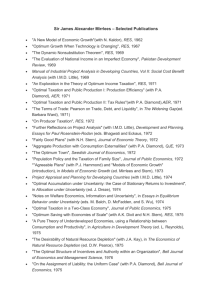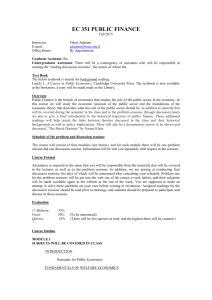Journal of Public Economics
advertisement
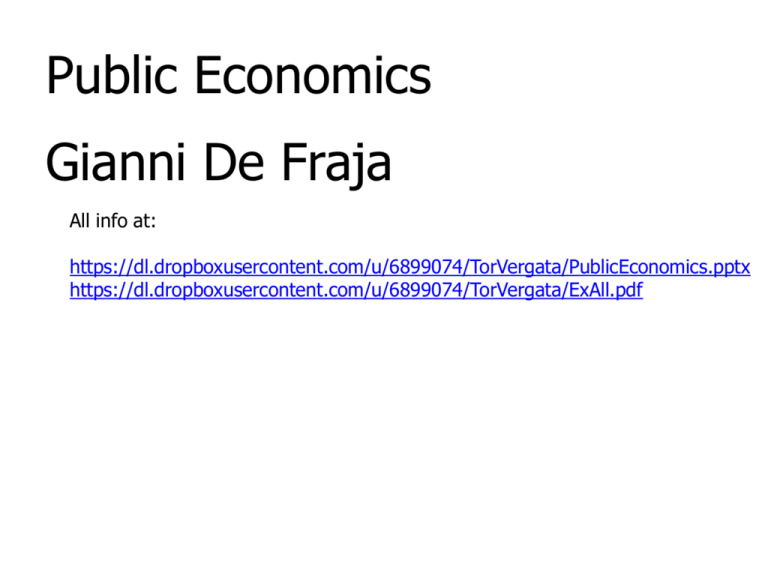
Public Economics Gianni De Fraja All info at: https://dl.dropboxusercontent.com/u/6899074/TorVergata/PublicEconomics.pptx https://dl.dropboxusercontent.com/u/6899074/TorVergata/ExAll.pdf Public Economics Assessment Rules (from SUA) The written exam consists of two questions, a mathematical exercise, similar but easier than those carried out during the course, and the discussion of an article and / or chapter chosen among those presented in class. The finale grade is obtained as the weighted average of the marks obtained in the two questions, with weights 0.6 and 0.4 for the higher and the lower mark respectively. That is, if x1 and x2 are marks in the two questions, the overall grade is given by voto, where: voto 0.4 x1 0.4 x2 0.2 max x1, x2 The time available for the examination is 90 minutes (an hour and a half) The last examination of each session will instead consist of three questions, and the candidate must choose to answer only two of these (if a candidate answers to three questions, two will be chosen at random from those to which you have responded): one of the three questions is an exercise, as described above, another one is a discussion of an article as described above, and the third will be a theme/open question, to answer by using the general knowledge of the field of public economics (and therefore with the knowledge and familiarity with a good manual of public economy, such as Rosen and Gayer). Apart from this choice of questions, the rules are identical to those given above (about voting and the weighted average of the two votes). The scale of the vote goes from 0 to 32, so students can take 30 even without answering perfectly two of them. Public Economics Mock exam I may hold a mock exam. This is a practice dry run for the “exercise part of the exam”. It will be more difficult (but you will have more time ) than the scheduled exams. I urge all of you to try to do it, since it has no cost and is excellent practice. The mark obtained can be used instead of the exercise part in the written exam, in conjunction with the presentation. Public Economics Presentations Students’ presentations These will be assessed and the student will be allowed to choose whether to have them included as an element of the final evaluation of the course. The aim of the presentation is to transfer and communicate new knowledge to a group of people who have a general knowledge of economics or finance, but not necessarily in possession of complete familiarity with all aspects of that topic. A skill that will be evaluated in the presentation is the ability to choose what needs to be explained and what you can assume that the public knows. "Wasting" time in explaining topics that the students of the master already know is not a good use of one's time. The presentations will be held in the last week of the course. The teacher will provide a list of approximately a hundred articles (available on the web), and each student must choose an article from those. All the articles selected by the students are part of the course programme and they can be included in examination questions in the module exams: In general, however, there will be wide choice regarding the topics to which students might be examined in each session. The presentation in PowerPoint (or Beamer pdf) must be sent to the teacher’s email address by the deadline communicated during the course. The presentation will last no more than 15 minutes. This limit may be reduced at 13 minutes depending on the number of presentations Written and verbal suggestions on presentation techniques will be given during the course. Each presentation will receive a detailed individual comment from the teacher, and, subjected to the student’s consent, it will be videotaped and uploaded on the YouTube website Public Economics FAQ: Presentations + Mock Exam How do Presentations + Mock Exam affect the mark. These are the rules: 1. If a student has a mark both in the presentation and in the Mock Exam he/she can record the weighted average of them at any exam session. 2. If the student sits the January/February exam and hands in the script after 45 minutes, having answered only one open question or only the exercise, then his/her mark is determined by weighted average of the mark of that part and the corresponding other part (that is, if he/she answers the exercise only his/her mark will be determined by the weigthed average of the exercise and the December presentation, if he/she answers the essay only his/her mark will be determined by the weigthed average of the exercise done in the December Mock exam and the essay). It is not necessary to declare in advance that one intends to do only half the exam, but it is necessary to hand in after 45 minutes. 3. There are no exceptions to this rule: the January/February session is the only one where it is possible to hand in the exam after 45 minutes, having answered only one question. For subsequent exam sessions, attendance to the exam implies that all marks obtained in December are cancelled. Lecture 1 Introduction The role of the state – Tax. – Expenditure. There is no specific reference. The introductory Chapters of many textbooks (Gruber, MylesHindricks, Myles, Rosen and Gayer. More detailed information for the UK is available in Barr “The Economics of the Welfare State”. Very specific details about the UK Tax system are available is the excellent “Mirrlees Review” (http://www.ifs.org.uk/mirrleesReview). This is a very long and detailed document, and the conclusion and recommendations chapter is a good place to start. Chapter 1 in Salanie, B. (2002), The Economics of Taxation, MIT Press, contains the theoretical introduction to taxation. Lecture 2 Simple Tax Models In Chapter 2 Salanie, B. (2002), The Economics of Taxation, MIT Press, there are several simple model of taxation in increasingly less simple set-ups). Chapter 3 and 4 contain very simple models of the theory of optimal taxation. Commodity (indirect) taxation in Chapter 3 and income (direct) taxation in Chapter 4. The model are highly simplified (but with all the original message intact) versions of the original difficult contribution, Diamond and Mirrlees (AER 1971) and Mirrlees (REStuds 1971). Lecture 3 Optimal Taxation Models – Commodity The revelation principle Chapter 3 and 4 contain very simple models of the theory of optimal taxation. Commodity (indirect) taxation in Chapter 3 and income (direct) taxation in Chapter 4. The models are highly simplified (but with all the original message intact) versions of the original difficult contribution, Diamond and Mirrlees (AER 1971) and Mirrlees (REStuds 1971). Lecture 3 considers indirect (commodity) taxation, in chapter 3. This lecture also introduce the revelation principle. It is hard to find a simple discussion of this profound result. Mas-Colell, Whinston and Greene (Ch 23) have a very rigorous treatment. Ditto for Kreps (Ch 18). The Game theory book by Fudenberg and Tirole treats the subject from p 255. Lecture 4 Optimal Taxation Models - Income Chapter 4 studies direct (income) taxation. The models are highly simplified (but with all the original message intact) versions of the original difficult contribution, Diamond and Mirrlees (AER 1971) and Mirrlees (REStuds 1971). An important document is the Mirrlees review. Time permitting some of its points will be touched upon (http://www.ifs.org.uk/mirrleesreview/pamphlet.pdf) Lecture 5 The theory of public procurement and regulation. The procurement model is from Laffont, Jean-Jacques and Jean Tirole, [1986] “Using cost observation to regulate firms”, Journal of Political Economy, 94, pp. 614-641, as presented in their book, Laffont, Jean-Jacques and Jean Tirole, [1993] A Theory of Incentives in Procurement and Regulation, The MIT Press, (Ch 1 & 2). Lecture 6 More on Tax. Taxations of savings. Problems of optimal taxation. Pigou taxation and Carbon and Green taxes. Chapters 6, 7, 8 and 10 in Salanie Lecture 7 Income transfers for poverty alleviation. Timothy Besley and Stephen Coate, “The Design of Income Maintenance Programmes”, Review of Economic Studies, 1995, 62: 187-221. And Chapter 9 in Salanie … as a side dish we can look at how rich are the rich ( http://www.nber.org/papers/w15408) Lecture 8 Goods provided by the State Public goods. Redistribution through provision. The case of health care. Any textbook will have relevant chapters (Gruber Ch 7; Hindricks and Myles Ch 5; Rosen and Gayer, Ch 4; Atkinson and Stiglitz, Ch 16 (the notation used here is from this book); More advanced, Laffont (Fundamentals of Public Economics, Ch 2). The paper sketched are: Besley, Timothy, and Stephen Coate, [1991], "Public Provision of Public Goods and the Redistribution of Income", American Economic Review, 81 pp. 979-84. Blackorby, Charles, and David Donaldson, [1988], "Cash Versus Kind, Self-selection, and Efficient Transfers", American Economic Review, 78 pp. 691-700 Lecture 9 Goods provided by the State General principle. Redistribution through provision. The optimal Education Policy. Arrow’s contribution, (Arrow, Kenneth J., [1971], "A Utilitarian Approach to the Concept of Equality in Public Expenditures", Quarterly Journal of Economics, 38 pp. 175-208). Sets the framework. I will deal in detail with De Fraja, Gianni, "The Design of Optimal Education Policies", The Review of Economic Studies, 69, 2002, pp 437-466. And its sister paper De Fraja, Gianni, [2005] “Reverse Discrimination and Efficiency in Education”, International Economic Review, 46, pp. 1009-1031. Lecture 10 Goods provided by the State Further application of the model. De Fraja, Gianni, and Paola Valbonesi, [2012] “The Design of the University System”, Journal of Public Economics, 96, pp. 317-330. Lecture 11 Goods provided by the State Pension and the social contract (if there is time). Benabou, Roland, [2000] “Unequal Societies: Income Distribution and the Social Contract”, American Economic Review, Vol. 90, No. 1, Mar., 2000.
